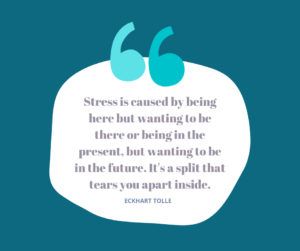During the time that I cared for Dad, I experienced the raging river of emotions that comes with caring for a family member. Overwhelmed and drowning, I navigated toward a more sustainable caregiving experience. When I learned to set boundaries, use mindfulness to enhance awareness, and identify when winning was losing, I began to manage the thoughts and emotions causing crippling stress. Here are six strategies that helped me find my sustainable caregiving path.
Set boundaries
We can set boundaries to protect our time, emotions, energy, capacity for compassion, and values. Setting boundaries is one of the most important and most difficult actions we take as family caregivers.
What are boundaries?
Boundaries are:
- Limits that we set to protect our physical and emotional well-being
- Guidelines and rules that are communicated to define what behaviors you will accept from those around you and what your response will be if your boundary is crossed
- Rules that help us define who we are and what we believe to be our responsibilities set around communication, interaction, and behavior
Why boundaries are important
In the beginning, I started by helping Dad a few days a week. It wasn’t my conscious intention, but two days a week turned into assisting with daily activities. Bit by bit, we can begin to give up our hobbies and interests until we are entrenched without a clear way out from under the tasks. Our well-being suffers when our priorities are unbalanced. While setting boundaries can feel selfish, the opposite is true. Well-maintained boundaries are a gift to yourself and those in your caregiving circle.
Effectively communicate boundaries
The confidence to stand firm will come from being clear in your intention and communication. Practice will make the process easier.

Best Practices:
- Be clear on your intention so that you can be clear in your communication
- Respectfully and with as few words as possible, communicate your boundary
- Word the request in terms of what you need and why you need it rather than usingthe word “you.” For example, “I need some space…” rather than “You need to stop…”.
- Share the consequences if the boundary is crossed
- Be firm and unapologetic
Cultivate mindfulness
Mindfulness focuses our attention on the present moment and helps calm our minds when emotions swirl. When we cultivate and practice mindfulness, we are able to act rather than react. In this way, mindfulness helps us minimize stress and regret. Mindfulness is integral to the effectiveness of each strategy.
What is mindfulness and why is it important?
During the first few years of caregiving, I felt utterly controlled by emotions. My internal and external responses felt automatic as if I didn’t have command over my reactions. I reacted inwardly and outwardly to Dad’s behaviors and opinions. I reacted when healthcare professionals were insensitive, or healthcare systems created rather than alleviated stress.

Caregiving worries can overwhelm our thoughts. Mindfulness is the ability to be fully present rather than ruminate on the past or worry about the future. When we are mindful of the present moment, we respond in accordance with our values. When we become skilled at being present, we counter the effects of stress and develop strong coping skills.
The benefits are many when we:
- Observe our thoughts and emotions without immersing ourselves in them; our responses become less impulsive and less reactive.
- Are nonjudgmental in our awareness, we can accept the experience with curiosity and openness.
- Improve self-reflection and self-observation, we develop and strengthen our coping skills.
- Focus on the present; the stress associated with ruminating on the past or future is minimized.
Opportunities to practice and cultivate mindfulness:
- Meditation practice
- Breathing exercises
- Yoga
- Looking out the window – What do you see? Look at each object as if you were seeing it for the first time. Notice the shapes, colors, movement. Practice increasing awareness without fixating on any one object.
- Walking – Perceive with all of your senses? How many things can you see, smell, hear, feel or taste?
- Transitions between activities – Take the seconds between putting down your phone and picking up your coffee cup to bring awareness to the moment.
Re-imagine Self-Care
You may not have recognized your hobbies and interests as self-care before caregiving. Going to the gym, reading for pleasure, spending time with friends was just a part of life.
As we begin to care for a family member and priorities shift, it is not uncommon to give up our interests and hobbies bit by bit until our entire life revolves around caregiving. When possible, it is better to share the caregiving responsibilities by delegating or accepting help so that you can continue to participate in your passions.
What is self-care reimagined?
Reimagining self-care involves:
- Identifying the activities that support our well-being and fit within our ever-evolving situation
- Prioritizing the activities by scheduling them or incorporating them into routines
- Protecting the activities and routines with boundaries
Why self-care is important
Self-care helps us stay stronger emotionally and physically so that we maintain our energy reserves and cultivate resilience. The repeated stresses of caregiving have less of a negative impact when our well-being remains a priority.
Early in my caregiving experience, rather than choose a self-care activity or taking a break, I made less healthy choices, which added to feelings of being out of control in a downward spiral.

As the experience intensifies, self-care opportunities may come in minutes rather than hours. We can make the most of those minutes by redefining self-care as often as necessary to fit within our day, within our routines.
What reimagined self-care looks like:
| Self-care prior to caregiving | Self-care during caregiving |
| Yoga: 1-hour yoga class 3 times per week at your local fitness club | Yoga: 5-15 minutes of yoga poses each day during your scheduled self-care break in your designated comfy corner in your family member’s home |
| Time with friends: Weekly get together for drinks and dinner to catch up on the latest news and gossip | Time with friends: Bi-monthly coffee to stay connected and hear the latest news and gossip or a walk outdoors while talking with a friend on the phone |
| Travel: A getaway to a distant location | Travel: 5-15 minutes learning a new language, culture, or cuisine so that when you can travel, your experience will be enhanced, and you stay connected to the joys of travel |
| Tennis: Participation on a team and travel to tournaments | Tennis: Meet a friend a couple of times a month for a game |
| Music: Attend a concert or music festival | Music: Have a calming playlist at the ready |
Let it Go
When we hold on tight to control, the only way to possess it, is to let go.
Caring for a family member is challenging. It is easy to get caught up in the conflict and feel like we are in a competition with a winner and a loser. We can all win when we play the game with intention and compassion.
What do we let go of?
When we relinquish our attempt to control people, processes, and outcomes, we regain control because frustrations no longer have power over our emotions. When we accept that our care recipient is an adult, free to make their own decisions, we deflate the built-up pressure and the stress from the conflicts. We can also accept that certain choices may produce consequences that impact the whole family, and at that point, we will deal with that new reality.
Why letting it go is important
What is the cost of winning vs. the cost of losing? You make your point. It is heard, resented, and disregarded. The time we spend pushing against immovable objects is time lost on reaching our meaningful objectives.

If your aim is that your family member experiences peace and feels supported, conflicts are counterproductive. If a goal is for you to come through the experience healthy and whole, constant resistance is counterproductive.
How to let go
Our concern for safety can be perceived as a threat to independence. When we begin with the end in mind, as Steven Covey says, we can align our actions with our long-term objectives. When you share a vision, you and your family member may be on differing paths, but walking your path no longer feels like a march into battle.
One of the biggest lessons in letting go of control and accepting that Dad was free to make his own decisions came in the early years of caregiving. Dad wanted to jump out of a plane for his 94th birthday. He brought it up every day with an insistence that triggered my angst. I wasn’t sure how serious he was, but it agitated me. He knew it and seemed amused by it. I discouraged, deflected, and resisted. Dad brought it up with his primary care physician, who said, “Why not?” It was one of those rhetorical questions that I could have answered with a monologue, but in shock, I just stammered, “Why not!” My response wasn’t a question. It was a way of relenting and releasing. My “Why not?” became “What the heck was all the fuss?”.
When we begin to look at the conflict from the other person’s point of view, we can manage our part of the discussion differently and then possibly let go of some of our motivation to control the outcome. Acceptance can help us put down the battle armor and change our tactics to achieve the desired win/win outcome.
Let it Out
It is crucial to be able to express emotions from events that cause you stress. The act of sharing or venting is a release that makes you feel lighter and less burdened. The key is to locate a listener who gets what you are going through, someone who has been through a similar experience. A regular practice of venting worked into a routine will help prevent the stressors from creating the layers of trauma that add to the overwhelm.
What do we need to let out?
Spinning thoughts and frustrations can cause the resulting negative emotions to fuel the cyclone, reducing your ability to think clearly or feel any sense of calm. Letting out the frustrations and, frankly, the fears is a must, because caregiving is sustainable when we believe that we can not only survive but thrive in our role.
Why venting is important
When the pressure from these emotions builds, the risks can include bursts of release in the form of angry reactions or harm to your health from holding in the negativity. However, when you can regularly let it out and prevent the pressure from building, the swirling subsides.
Venting opportunities
Venting opportunities include support groups, a professional including a counselor, therapist, spiritual advisor, or caregiver coach. Social media forums also offer a chance to receive and give support. A friend or relative who has cared for a family member might provide the support that feels supportive. Venting to someone who has not had a similar experience can leave us feeling worse rather than better if our frustrations and worries are not validated.
Writing is another form of venting. Keeping a journal will enable you to process the complexities of caregiving, the emotions, the fear, the confusion. It can help you capture the fun and funny moments. You will have a record of the experience, a travel journal that documents the caregiving journey.

Planning
Caregiver worries are real. These worries can cloud our thinking and cause us to feel powerless and overwhelmed. The stress of caring for a family member intensifies with each unexpected event.
What plans do we make?
When we face the what-ifs head-on and imagine what we might encounter, we begin to see what questions we need to ask and what information we can gather to make a plan. The research will lead to resources, and the answers will lead us to more questions until we fill in the vastness of the what-if with a strategy, a plan. We might make a plan to provide care in our home or to add outside help when the time is right. We might prepare for an unexpected hospital stay. We can plan for the time that your family member will no longer be able to drive. Let your worries lead the way to the plans.
Why planning is important
When we make a plan, and often a plan A, B, and C, we can stop the fretting. We can set the concern aside and focus on the present when we have a plan. We feel prepared and empowered. Your power lies in the plan.

Sustainable Caregiving Support System
In the first few years, I was aware of the need to support my emotional, mental and physical state of being, but building a support system was a lot like playing a game of Jenga and I wasn’t in the mood for games. Just when things started to look stable, the whole structure crumbled. Other days, it felt like I was trying to assemble a jigsaw puzzle, but the pieces morphed into different shapes that wouldn’t fit together.
I was certain that there was a missing piece. I couldn’t understand why some caregivers were able to manage gracefully with gratitude and I felt like I was seated atop an unstable tower of blocks that repeatedly imploded. When the pieces in my support system finally started to fall into place, it became clear which pieces fit and which pieces needed to be discarded. Activities that had not previously offered relief, began to provide a tremendous amount of support.
The strategies work best when they are combined and flexible. Caregiving requires that we frequently modify our priorities, and the strategies must be equally fluid. A self-care activity that reduces stress one week, may not bring the calm you seek the following week. Trial and error lead to the ability to adjust more quickly. The strategies support you when they are in sync with each other and with your needs.
Navigating the Caregiver River: A Journey to Sustainable Caregiving is available on Amazon. Also, check out the Self-Caregiving Strategies Podcast.
Schedule Theresa Wilbanks to speak on caregiving and empower the caregivers in your workplace or community with the 12 Sustainable Caregiving Strategies.
Advice offered is for general information only; please contact your healthcare team, legal or financial advisors to guide your particular situation.

